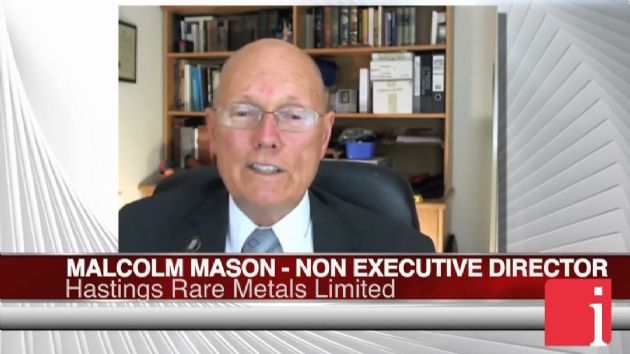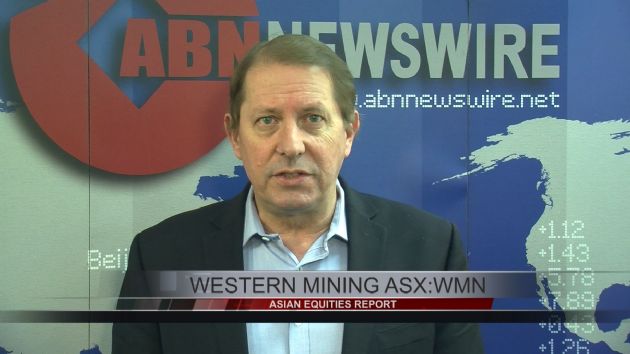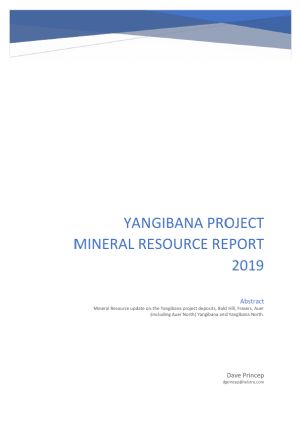
13% Increase in Measured and Indicated Mineral Resources
Perth, Oct 31, 2019 AEST (ABN Newswire) - The Directors of Hastings Technology Metals Limited ( ASX:HAS) (
ASX:HAS) ( 5AM:FRA) are pleased to announce a 13% increase in Measured plus Indicated Mineral Resources (for those deposits forming the basis of the Definitive Feasibility released in November 2017) compared to the most recently announced Mineral Resource estimate in November 2018 (ASX announcement titled "INCREASE IN MEASURED AND INDICATED RESOURCES AT YANGIBANA PROJECT" 28 November 2018). Measured plus Indicated Mineral Resources now stand at 15.1Mt within a total Mineral Resource of 21.3Mt. The total updated Measured and Indicated Mineral Resource now hosts approximately 60Kt of neodymium and praseodymium oxide, an increase of 7%, which forms the basis of the Company's main economic driver.
5AM:FRA) are pleased to announce a 13% increase in Measured plus Indicated Mineral Resources (for those deposits forming the basis of the Definitive Feasibility released in November 2017) compared to the most recently announced Mineral Resource estimate in November 2018 (ASX announcement titled "INCREASE IN MEASURED AND INDICATED RESOURCES AT YANGIBANA PROJECT" 28 November 2018). Measured plus Indicated Mineral Resources now stand at 15.1Mt within a total Mineral Resource of 21.3Mt. The total updated Measured and Indicated Mineral Resource now hosts approximately 60Kt of neodymium and praseodymium oxide, an increase of 7%, which forms the basis of the Company's main economic driver.
Charles Lew, Hastings Executive Chairman, said "we are extremely pleased that this work has not only confirmed our existing Mineral Resources but has significantly increased the Measured and Indicated portions which drive Mining Reserves. We are confident that the expected increase in Ore Reserve will extend the mine life which underpins the project financing."
Summary of Mineral Resource Changes
The total Mineral Resources as at October 2019 are shown in Table 1. The new Mineral Resources are based on the re-estimated and updated deposits as listed in Table 2* plus the previously announced deposits listed in Table 4* which have not been changed since the last Mineral Resource announcement dated 28 November 2018.
Compared to the previously announced Mineral Resource in November 2018;
- Measured and Indicated Tonnes increased by 13% or 1.7Mt
- Measured and Indicated Nd2O3+Pr6O11 tonnes increased by 7% or 4,000t
- Inferred Tonnes decreased by 25% or 2.1Mt
- Measured and Indicated Nd2O3+Pr6O11 grade decreased 0.03% to 0.39%
- Total Mineral Resource Tonnes decreased by 2% to 21.25Mt
- Total TREO Grade decreased by 4% to 1.12%
A Mineral Resource re-estimation was instigated as part of the financial due diligence process currently being completed by Hastings. This audit check and validation process was completed on only those deposits which form the basis of the economic analysis included in the Definitive Feasibility Study released in November 2017, as per Table 2* below.
The work undertaken to re-estimate the deposits was completed by Gill Lane Consulting and incorporates all of the information and data that was used in the previous Mineral Resource estimate announced on 28 November 2018. No new data was used in the re-estimation process.
Table 4* represents a list of deposits where no activity or re-estimation of Mineral Resources was completed. These deposits remain unaltered as per the Mineral Resource announcement dated 28 November 2018.
The work completed on the unaltered deposits was completed by Lynn Widenbar and Associates incorporating all the information and data as per the previous Mineral Resource announcement from 28 November 2018.
Geology
The near surface mineralisation throughout the Yangibana Project is hosted by iron oxides and hydroxides termed ironstone, being the alteration products of the primary hosts ferro-carbonatite and phoscorite intrusive veins. The main rare earths-bearing mineral is monazite which has locally undergone alteration at shallow depths (to 25m depth) to its hydrous equivalent rhabdophane and to rare earths-bearing aluminium-phosphates such as florencite.
The deposits occur as narrow but strike extensive veins that have a range of dips from almost horizontal (10-20o) to sub-vertical. The Fraser's deposit has the most extreme range from 5o in portions towards its north-eastern end to 65o at its southwestern end. Average true thickness varies from 2.2m to 3.5m throughout the Yangibana deposits although locally true thicknesses in excess of 20m occur.
Drilling
Hastings has completed eight drilling programmes comprising both reverse circulation (RC) and diamond drilling totalling more than 1,500 holes for 80,000m. Of these 127 holes for 7,485m are diamond holes.
Holes were initially drilled at 50m spacings along strike and down dip. Infill drilling in areas with Mineral Resource potential has been undertaken at 37.5m, or less, spacing.
Most drillholes were vertical, subject to access availability, with holes into the steeper mineralised zones (Auer, Auer North, the southeastern portion of Fraser's) being at -60o or - 70o. Internal surveys were carried out at 30m intervals downhole by the drilling contractors using a Reflex electronic single-shot camera within a stainless-steel drill rod.
Collar surveys were carried out by the Company using a Trimble RTX R1 GNSS receiver, with accuracies of approximately 50cm. The high-resolution Digital terrain Model commissioned by the Company has been used as the topographic control for all drillholes. A Relative Level (RL) was assigned to each drillhole collar based on the high-resolution DTM using Mapinfo Discover 3D.
RC holes have been drilled using a nominal 51/4 inch diameter face-sampling bit. Samples have been collected through a built-in cyclone with a triple-tier riffle-splitting system providing a large sample of approximately 25kg and a sub-sample of 2-4kg of which selected samples were sent for analysis, from each metre drilled. Field duplicates, blanks and Reference Standards were inserted at a rate of approximately 1 in 20.
Diamond core has been drilled at HQ size. The core is logged, and prospective zones are sawn into half and one half is then quartered with one quarter sent for analysis. Assayed intervals are based on geology with a minimum length of 0.2m.
Sampling
Samples were routinely sent to Genalysis in Perth for analysis using techniques considered appropriate for the style of mineralisation. Samples were analysed for the range of rare earths, rare metals (Nb, Ta, Zr), thorium and uranium and a range of common rock-forming elements (Al, Ca, Fe, Mg, Mn, P, S, Si, Sr). Duplicate samples have been sent to SGS Laboratories for cross-checking.
Once assay data were returned, the elemental values were converted to oxides using standard factors.
Quality Control
In total, the quality control regime executed has provided reasonable support for the accuracy and precision of the assay results underpinning the mineral resource estimate. The vast majority of results for standards remain within the normal control limits of 2 standard deviations. One standard GRE-01 that failed 11 out of the 50 certifying analyses suggested either an issue with the standard itself or that one of the certifying analytical methods was inappropriate for the material.
Bulk density has been completed by either the Company or at independent laboratories on core from each of the main deposits. Samples from each of the oxidised, partially oxidised, and fresh mineralisation zones have been tested with results feeding into the Mineral Resource estimations based on weathering surfaces as defined by the Company.
A review of the bulk densities showed variations in density in line with the type of mineralisation that was encountered in the diamond drilling.
Interpretation of Geology - Wireframing
Each of the five (5) re-modelled deposits was assessed for grade and geological continuity and the mineralised wireframes were defined around a combination of TREO grades and, where TREO grades were low and mineralisation continuity was believed to exist, Fe grades were used as a substitution for mineralisation.
The drilling data was limited to selected assay intervals with large sections of the drilling unsampled in areas where no mineralisation was believed to exist. Within the Mineral Resource estimation data set the unsampled zones within the drilling were replaced with zero values. In a limited number of instances, for geological consistency, the mineralised envelopes were carried through areas within drill holes that had not been sampled. In these cases, the minimum thickness of intercept was assumed to be 2m and, in common with the rest of the drilling, these intervals were assumed to be at zero grade.
In a limited number of cases where the assay values did not meet the TREO cut-off grade criteria for wireframing assessment of the mineralisation was undertaken using elevated Fe values. This was done to enable a consistent mineralised envelope with the low TREO (and other element) values incorporated. In general, these areas are of limited extent.
Cut-Off Grades
Following the review of the original Yangibana mineral resource estimates, based on an elevated Nd2O3+Pr6O11 0.2% cut off, a decision was taken to re-wireframe all of the deposits that contained Ore Reserves using a TREO cut-off grade in order to improve the geological and grade consistency of the modelled wireframes. In this instance a TREO grade of approximately 0.18% was chosen for the wireframing value as this was considered to represent the transition between consistently mineralised and non-mineralised material. In cases where a lower grade was adjacent to significantly higher grades the lower grade interval was incorporated into the wireframe as these were constructed around the final 1m composites rather than the original selective sampling.
This process created a level of conservatism whereby lower grades of Nd2O3+Pr6O11 were incorporated into the wireframe than was previously the case. Additional conservatism was added by only allowing the wireframes to be extrapolated down dip below the last drill hole, using the geological convention of 50% of the local drill hole spacing. The effect of this can be seen in Figures 4-7.
This interpretation differed from the previous Mineral Resource estimate which was undertaken using a sectional interpretation combining logged geology and a nominal 0.2%Nd2O3+Pr6O11 cut-off to define the mineralisation envelope.
*To view tables and figures, please visit:
https://abnnewswire.net/lnk/85DC7DNR
About Hastings Technology Metals Ltd
 Hastings Technology Metals Ltd (ASX:HAS) (FRA:5AM) is advancing its Yangibana Rare Earths Project in the Upper Gascoyne Region of Western Australia towards production. The proposed beneficiation and hydro metallurgy processing plant will treat rare earths deposits, predominantly monazite, hosting high neodymium and praseodymium contents to produce a mixed rare earths carbonate that will be further refined into individual rare earth oxides at processing plants overseas.
Hastings Technology Metals Ltd (ASX:HAS) (FRA:5AM) is advancing its Yangibana Rare Earths Project in the Upper Gascoyne Region of Western Australia towards production. The proposed beneficiation and hydro metallurgy processing plant will treat rare earths deposits, predominantly monazite, hosting high neodymium and praseodymium contents to produce a mixed rare earths carbonate that will be further refined into individual rare earth oxides at processing plants overseas.
Neodymium and praseodymium are vital components in the manufacture of permanent magnets which is used in a wide and expanding range of advanced and high-tech products including electric vehicles, wind turbines, robotics, medical applications and others. Hastings aims to become the next significant producer of neodymium and praseodymium outside of China.
Hastings holds 100% interest in the most significant deposits within the overall project, and 70% interest in additional deposits that will be developed at a later date, all held under Mining Leases. Numerous prospects have been identified warranting detailed exploration to further extend the life of the project.
Brockman Project
The Brockman deposit, near Halls Creek in Western Australia, contains JORC Indicated and Inferred Mineral Resources, estimated using the guidelines of JORC Code (2012 Edition).
The Company is also progressing a Mining Lease application over the Brockman Rare Earths and Rare Metals Project.
Hastings aims to capitalise on the strong demand for critical rare earths created by the expanding demand for new technology products.
| ||
|











